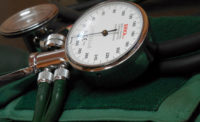7 healthy habits that could save billions in Medicare costs

More than $41 billion a year in Medicare costs could be saved if all beneficiaries achieved ideal levels for five to seven heart-healthy habits to reduce cardiovascular risk, according to new research in Journal of the American Heart Association, the Open Access Journal of the American Heart Association (AHA)/American Stroke Association.
The AHA’s Life’s Simple 7 is a composite measure of seven modifiable heart-healthy factors: cigarette smoking, physical activity, diet, body mass index, blood pressure, cholesterol and glucose levels.
Researchers estimated the annual financial impact of Life’s Simple 7 compliance using one year of follow-up data from the Reasons for Geographic And Racial Differences in Stroke (REGARDS) study, a national, population-based, longitudinal study. They focused on Medicare claims for 6,262 beneficiaries over the age of 65 with fee-for-service coverage and no prior history of cardiovascular disease.
In primary analyses, researchers found:
- Only 6.4 percent of participants had five to seven ideal factors.
- Participants with fewer Life’s Simple 7 scores were more likely to be women, black or be unmarried, or have an annual income less than $20,000 or have less than a high school education.
- Those with higher scores were also less likely to have all-cause and cardiovascular disease-related inpatient or outpatient encounters in the year following their in-home study visit.
- Total inpatient and outpatient healthcare expenditures were $5,016 less for participants with the most ideal heart-healthy factors compared to those with the least number of factors.
By extending estimates from the primary analyses to corresponding 2014 Medicare beneficiaries, researchers found:
- Participants with fewer than five of the heart-healthy measures accounted for more than half of all inpatient costs each year, and approximately one-third of total outpatient claims.
- The potential annualized cost reduction is $41.2 billion for inpatient, outpatient and total expenditures, respectively, if all Medicare beneficiaries had five to seven Life’s Simple 7 factors.
“The actual cost for persons with fewer than five to seven factors is almost certainly higher,” according to Kristal J. Aaron, Dr.P.H., M.S.P.H., lead author and clinical data manager at the University of Alabama in Birmingham. “Skilled nursing facility, home health and hospice care, durable medical supplies, and medications were excluded in this analyses; thus, our study was limited to inpatient and outpatient visits for beneficiaries with Medicare fee-for-service in the 2014 calendar year, so this is probably a very conservative estimate.”
She added that the data suggests that public health strategies and initiatives improve the number of Life’s Simple 7 factors across the population and age spectrum, even those over 65 years of age “offer the potential for significant cost savings, not just better health outcomes and quality of life.”
Co-authors are Lisandro Colantonio, M.D., M.Sc.; Luqin Deng, Ph.D., M.P.H.; Suzanne Judd, Ph.D.; Julie Locher, Ph.D.; Monika Safford, M.D.; Mary Cushman, M.D., M.Sc.; Meredith Kilgore, Ph.D., M.S.P.H.; David Becker, Ph.D.; and Paul Muntner, Ph.D. Author disclosures are on the manuscript.
Looking for a reprint of this article?
From high-res PDFs to custom plaques, order your copy today!





